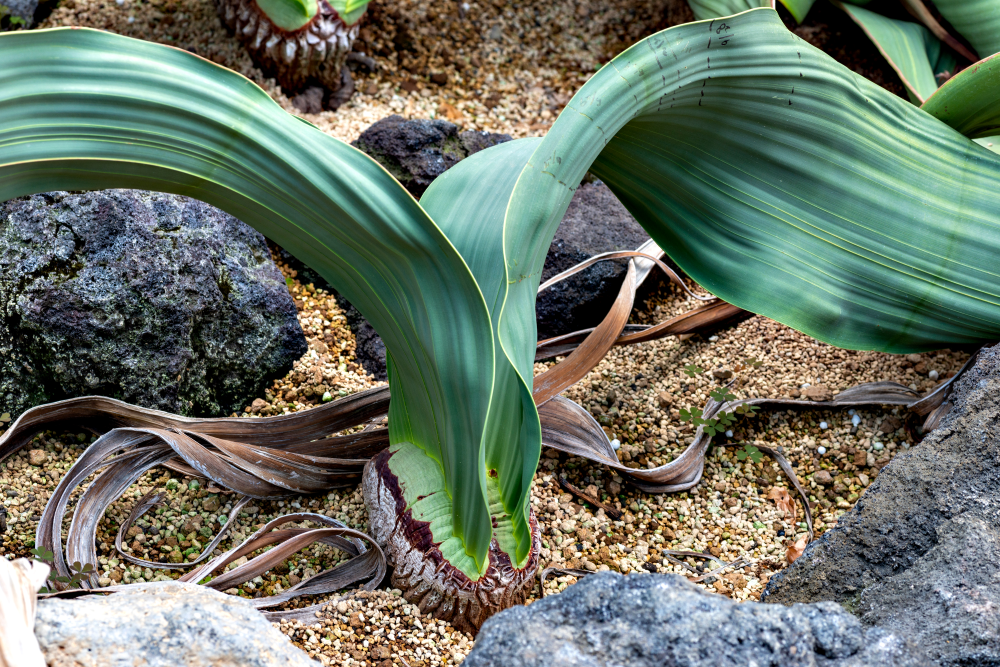In the hyperarid desert bridging Angola and Namibia lives a plant known by the Afrikaans tweeblaarkannidood, meaning “two leaves that cannot die”. It’s a fitting title for Welwitschia mirabilis, an alien-like plant whose astonishing biology and extreme longevity has been studied extensively. The upper estimates for maximum age stretch as far as 3,000 years, not bad for what Kew Magazine called “the ugliest plant in the world” back in the ’90s.
ADVERTISEMENT
It was named after Austrian botanist Friedrich Welwitsch in 1859 who, upon seeing it for the first time, Kew says, “could do nothing but kneel down and gaze at it, half in fear lest a touch should prove it a figment of the imagination”. Sounds like a long time ago, but any seedlings around when Welwitsch was on his knees would be considered young whippersnappers today. At least, by Welwitschia standards.
Welwitschia mirabilis, an ancient superhero
According to Indiana University Bloomington, these plants are the only living genus of the family Welwitschiaceae, which is why some consider them to be a “living fossil”. Specimens have been carbon-dated to reveal ages of around 500 to 600 years old, but their estimated lifespan is thought to be between 400 to 1,500 years, and some of the largest specimens may even extend to nearer 3,000 years.
A 2021 study explored the genetic mechanism underpinning its extreme longevity and found that Welwitschia underwent a duplication event 86 million years ago, providing the extra genetic material that helped it adapt to desert conditions. Its perpetual leaves are the result of the genes KNOX1, ARP3, and ARP4 that keep its basal meristem growing indefinitely, and it also has multiple copies of genes that protect against heat and drought. Something of a desert life superhero, and that’s before you consider all the good it does for the environment.

Welwitschia’s leaves start out normal enough and then they just keep on growing.
Image credit: Trialist / Shutterstock.com
Adapting to desert life
The environment in which Welwitschia grows is so dry, in fact, that it has evolved what’s known as crassulacean acid metabolism (CAM) to survive. CAM is a carbon fixation pathway that’s evolved in several plants that live in arid conditions, and it’s a beneficial adaptation because it sees the plant switch between photosynthesis during the day to gas exchange at night. For a while, nobody was quite sure if Welwitschia really was a CAM plant, but after 20 years of research, scientists were able to confirm that Welwitschia does indeed utilize CAM (even if nobody knows why it doesn’t use it as much as expected).
What little water it does get is usually sweeping through in the form of fog, and it’s here that its bafflingly long leaves come in handy. They act as a moisture trap, but when in doubt, Welwitschia also have long taproots that seek out water underground.
Those leaves have earned a Guinness World Record for being the longest-lived leaves of all plants, with a mean total leaf area of 1 square meter (10.7 square feet). They never shed their leaves, but they do keep growing as the tips get worn away by desert life. The total plant can grow to be massive, with some of the most ancient individuals sprawling over 10 meters (33 feet) in circumference.
Welwitschia’s many ecosystem services
Being so large and gangly comes with its perks, as Welwitschia is a “litter trap” that catches organic matter being blown across the desert, enriching what would otherwise have been infertile soil. Their size also comes in handy for the animals that use it for shelter, like Gray’s larks, snakes, lizards, scorpions, spiders, and insects. Larger animals like oryx and springbok chew its leaves for moisture.
If beauty is in the eye of the beholder, then it looks like “the ugliest plant in the world” appears downright sexy to a thirsty antelope, actually. And if you think that’s weird, just wait until to hear what the latest celebrity bloom at Kew smells like.
Source Link: Alien Plant With World’s Longest-Living Leaves Can Survive For Over 1,000 Years